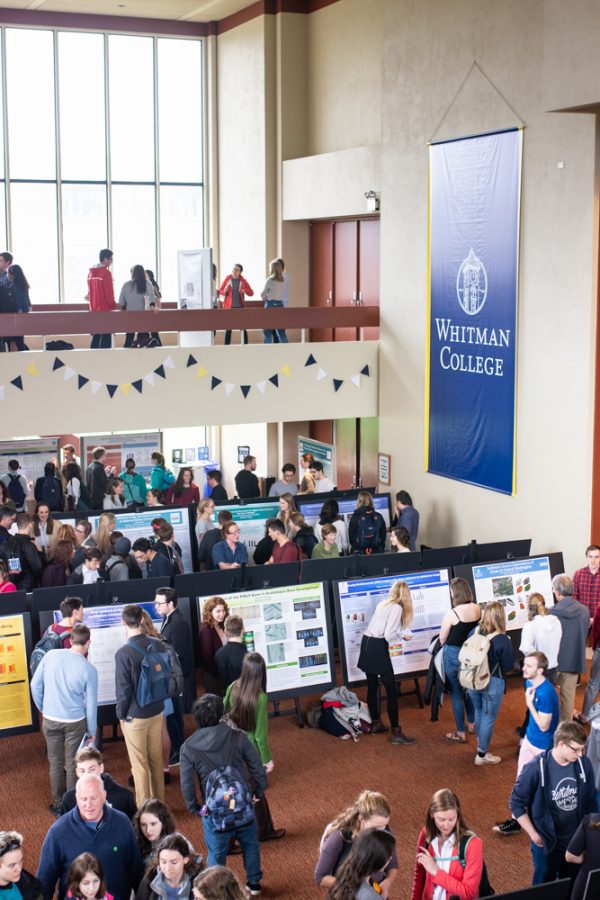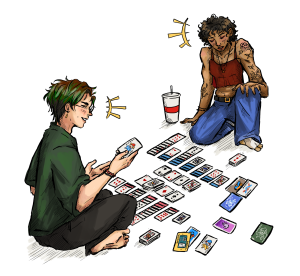Whitman Undergraduate Conference Showcases Student Research
April 11, 2019
The 21st annual Whitman Undergraduate Conference brought 86 student panel presenters, 34 musicians, and a record total of 69 poster presenters (representing 57 poster projects), in addition to the many attendees. The Conference gave students, faculty, staff and Walla Walla community members the opportunity to witness and showcase student research from all four class cohorts on Apr. 9.
Panel presentations were categorized based on several different themes, including “Media and Modern Times,” “Dark Matter and DNA,” “Race, Hate, and Trauma,” “Species, Evolution, Adaptation,” “Environmental Justice” and many others. In addition to this wide diversity of research topics, Keith Raether, Director of the Office of Fellowships and Grants and Chair of the Committee for the Whitman Undergraduate Conference, also thinks the Undergraduate Conference is unique in that it allows students to take the lead.
“[It’s] a day where the roles are reversed,” Raether said. “[The students] are the teachers, and faculty and staff are the students.”
Approximately 200 student presenters contributed to making this year’s Undergraduate Conference an incredible learning experience for faculty, staff, other Whitman students and community members. Below are three such students who took on the role of professor for a day.
Nina Sharp, “Trends in Women’s Labor Force Participation in the United States, 1979-2016”
Senior Economics major Nina Sharp’s project emerged out of research that she did in an Economics course last semester. She chose to focus on women’s participation in the workforce partly because of the pervasiveness of the topic in her own life.
“As someone who will be graduating and entering the workforce as a young woman later this year, this has been a topic that’s been of real interest to me,” Sharp said.
Aside from her personal connection, Sharp’s research was inspired by the lack of consensus among economists with regards to this particular issue.
“What’s actually really interesting is that women’s participation in the labor force was steadily increasing all the way up to 2000, and since then it’s been decreasing… and a lot of economists are still trying to figure out why,” Sharp said. “I wanted to see if I could develop my own model to address this trend, [one] that would accurately represent some of the trends that are happening.”
Sharp incorporated nine independent variables in her preliminary research and, using linear progression, created a model to generate estimates of women’s labor force participation for her specified time period, which she then compared to published data.
“In some places… my predicted numbers were very close to the actual numbers,” Sharp said. “But then, in the last 10 or so years, when women’s labor force participation has been going down, my model predicted that it should start trending back up again, so there’s kind of discrepancy there.”
Sharp hopes to continue this research and broaden the scope of her data by incorporating more variables.
“There are a lot of things I didn’t include in my model that could potentially go toward future analysis,” Sharp said. “[For example,] raising childcare costs… and measures such as the Washington Paid Family Medical Leave Act… it’ll be interesting to see impacts of policies like that as well on the trend.”
Chloe Daikh, “Confronting Ancient and Modern Sexism Through the Poetry of Sulpicia”
Drawing on her own experiences in her major and in Roman History, sophomore Classics and History major Chloe Daikh examined the role of women in ancient Rome through researching Sulpicia, the only female Roman poet whose work has survived. Many scholars believe that she authored six short poems, all addressed to a lover named Cerinthus.
“There are… three groups in classical scholarship about her,” Daikh said. “[One thinks that] the poetry was written by a man impersonating a woman, and then another group that thinks she wrote poetry as a woman but that it’s emotional and confessional… and then there’s the third group, which is made up of mostly women, that thinks she wrote poetry and [that it’s valid].”
The pervasiveness of misogyny in the field of Classics is part of the reason Daikh decided to study Sulpicia, and is also part of the reason she decided to present at the Undergraduate Conference.
“[My research topic is] part of an ongoing conversation about the role that Classics and Classical Studies will play in the future of academia,” Daikh said. “I care about it a lot and want to be a part of that conversation.”
She also sees the Undergraduate Conference as an opportunity to prepare for future projects and presentations.
“This research that I’ve done, I’d like to take on the road to other conferences,” Daikh said. “The Whitman Undergraduate Conference is a good stepping stone.”
Alexander Shaw, “Bound States of Dark Matter”
Through examining dark matter (a hypothetical type of matter, speculated to make up a significant portion of the matter in the universe) and its potential to interact with other particles and itself, Senior Physics and Mathematics major Alexander Shaw also raises questions about the structure of the universe, as well as dark matter itself.
“Assuming that dark matter exists and that it’s a particle, and [that] there’s an interaction between the dark matter particles, the question I’m trying to answer is whether or not few body bound states can occur,” Shaw said. “Given an interaction strength between the particles, [I’m addressing] whether or not they can form a bound state of up to three or four particles.”
Shaw’s research is supported not only by his investigations of dark matter itself, but also by his own understandings of other related scientific processes.
“It’s sort of analogous to understanding how nucleosynthesis occurs, and how likely [it is] that that occurs, for different numbers of protons and neutrons,” Shaw said. “So some number of particles are easier to bind together than others, and that sort of structure determines what sort of elements are unstable and what elements are stable, and there could be a similar thing for dark matter.”
For Shaw, the Undergraduate Conference is not only an opportunity to share research — it is also a way to receive audience feedback.
“It’s kind of like a peer review process, which I don’t think you get [as an] undergraduate a lot,” Shaw said. “I thought [presenting] would be a good exercise [in] explaining [my project] to a general audience, because I think you should be able to do that if you’re studying science.”






